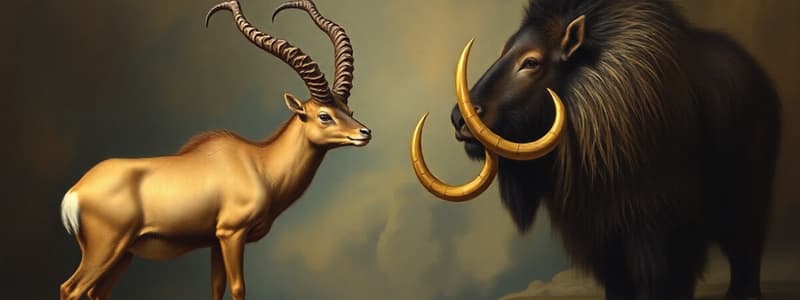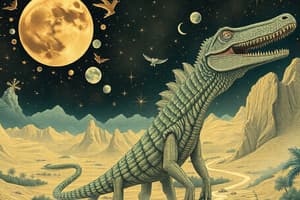Podcast
Questions and Answers
What was the primary cause of the extinction of the Pyrenean Ibex?
What was the primary cause of the extinction of the Pyrenean Ibex?
- Climate change
- Natural predators
- Habitat loss
- Human hunting (correct)
What was the fate of the only Pyrenean Ibex that was cloned?
What was the fate of the only Pyrenean Ibex that was cloned?
- Died from genetic abnormalities
- Survived only a few minutes (correct)
- Successfully bred with other goats
- Lived for several years
Which extinct animal is mentioned as being genetically too different to be de-extincted?
Which extinct animal is mentioned as being genetically too different to be de-extincted?
- Pyrenean Ibex
- Woolly Mammoth
- Mastodon (correct)
- Passenger Pigeon
What was the last known specimen of the Pyrenean Ibex named?
What was the last known specimen of the Pyrenean Ibex named?
Which species is suggested as a close relative of the Passenger Pigeon for possible de-extinction?
Which species is suggested as a close relative of the Passenger Pigeon for possible de-extinction?
What significant concern is associated with cloning the Pyrenean Ibex?
What significant concern is associated with cloning the Pyrenean Ibex?
What date did the last Passenger Pigeon die?
What date did the last Passenger Pigeon die?
What was one of the ecological roles that the Passenger Pigeon played before its extinction?
What was one of the ecological roles that the Passenger Pigeon played before its extinction?
What was a major factor that contributed to the extinction of the Passenger Pigeon?
What was a major factor that contributed to the extinction of the Passenger Pigeon?
What was the outcome of the attempt to clone the Pyrenean Ibex?
What was the outcome of the attempt to clone the Pyrenean Ibex?
Which of the following is a concern associated with de-extincting the Pyrenean Ibex?
Which of the following is a concern associated with de-extincting the Pyrenean Ibex?
What is a significant difference between mastodons and mammoths?
What is a significant difference between mastodons and mammoths?
Which extinct species is believed to have played a role in controlling Lyme disease?
Which extinct species is believed to have played a role in controlling Lyme disease?
What does the cloning of the Pyrenean Ibex demonstrate about current biological technologies?
What does the cloning of the Pyrenean Ibex demonstrate about current biological technologies?
What is a crucial ecological benefit of potentially reviving extinct species like the Passenger Pigeon?
What is a crucial ecological benefit of potentially reviving extinct species like the Passenger Pigeon?
Which statement accurately describes the genetic relationship between mastodons and modern elephants?
Which statement accurately describes the genetic relationship between mastodons and modern elephants?
What was the primary goal of attempting to clone the Pyrenean Ibex?
What was the primary goal of attempting to clone the Pyrenean Ibex?
What limitation did researchers face after cloning the single Pyrenean Ibex?
What limitation did researchers face after cloning the single Pyrenean Ibex?
Why is it said that mastodons cannot be brought back through de-extinction efforts?
Why is it said that mastodons cannot be brought back through de-extinction efforts?
What ecological role did the Passenger Pigeon play before its extinction?
What ecological role did the Passenger Pigeon play before its extinction?
What major concern regarding animal cloning was highlighted in relation to the Pyrenean Ibex?
What major concern regarding animal cloning was highlighted in relation to the Pyrenean Ibex?
What was a significant environmental factor affecting potential de-extinction projects for species like the Mastodon?
What was a significant environmental factor affecting potential de-extinction projects for species like the Mastodon?
What does the attempt to revive extinct species like the Passenger Pigeon suggest about scientific capabilities?
What does the attempt to revive extinct species like the Passenger Pigeon suggest about scientific capabilities?
What is a key argument against the de-extinction of extinct species?
What is a key argument against the de-extinction of extinct species?
Flashcards are hidden until you start studying
Study Notes
### Pyrenean Ibex
- The Pyrenean Ibex, also known as the bucardo, is a subspecies of Spanish Ibex that went extinct in 2000.
- It was the first extinct species to be de-extinctified, but the clone only lived for a few minutes.
- The last Pyrenean Ibex, named Celia, died due to a falling branch.
- Scientists used frozen skin samples from a 1999 specimen to create clone embryos by inserting the bucardo's DNA into goat eggs.
- Only one bucardo was born from 208 implanted embryos and it died shortly after birth.
- Cloning the Pyrenean Ibex raises concerns about lack of genetic diversity making the species more vulnerable to diseases and climate change.
- De-extinction of the Pyrenean Ibex could help restore biodiversity and its natural ecosystem.
Mastodon
- Mastodons are extinct members of the order Proboscidea, related to mammoths and modern-day elephants.
- They were endemic to North America and became extinct around 10,000 years ago.
- Mastodons existed 20 million years before mammoths, making de-extinction impossible due to significant genetic differences.
Passenger Pigeon
- The Passenger Pigeon (Ectopistes migratorius) is an extinct species of pigeon that was once abundant in the Great Plains.
- The last Passenger Pigeon, named Martha, died in 1914.
- The Passenger Pigeon went extinct due to hunting and deforestation.
- De-extinction is possible through breeding with its closest relative, the band-tailed pigeon, using preserved DNA.
- De-extinction could restore the ecosystem and biodiversity but faces criticisms about feasibility and potential risks.
- Concerns include the need for a large population to avoid extinction and potential ecological disruptions due to habitat changes and food sources.
- Bringing back the Passenger Pigeon could lead to pest issues and the creation of dangerous retroviruses.
Pyrenean Ibex
- The Pyrenean Ibex, also known as the bucardo, is a subspecies of Spanish Ibex that became extinct in 2000.
- It was the first extinct species to be successfully de-extinctified, although only for a few minutes.
- The species died out due to human hunting and the last known specimen, Celia, was killed by a falling branch.
- Scientists were able to create bucardo clone embryos by inserting DNA from a frozen skin sample into goat eggs.
- Out of 208 embryos implanted, only one bucardo was born, but it died within a few minutes.
- The main concern with de-extinction in this case is the lack of genetic diversity, making the species vulnerable to disease and climate change.
Mastodons
- Mastodons are an extinct species from the order Proboscidea, related to mammoths and elephants.
- They were endemic to North America and became extinct around 10,000 years ago.
- Mastodons existed 20 million years before mammoths, making de-extinction impossible due to significant genetic differences.
- The habitat that mastodons roamed has changed dramatically, making it impossible to reintroduce them successfully.
Passenger Pigeon
- The Passenger Pigeon (Ectopistes migratorius) is an extinct species of pigeon that was once abundant in the Great Plains.
- The last known Passenger Pigeon, Martha, died on September 1, 1914.
- The Passenger Pigeon died out due to hunting and deforestation.
- Scientists could potentially de-extinct the species through selective breeding with its closest relative, the Band-tailed pigeon, as DNA is available from preserved specimens.
- The species may have helped to suppress Lyme disease by consuming the ticks that carry the disease.
- Reintroducing Passenger Pigeons could present significant challenges, including the need for large populations to avoid predator saturation, the lack of their original habitat, and the potential negative impact on existing ecosystems.
- The extinction of the American Chestnut, a key food source for Passenger Pigeons, further complicates de-extinction efforts.
- De-extinction of the Passenger Pigeon could potentially lead to the emergence of new retroviruses.
Pyrenean Ibex
- The Pyrenean Ibex, also known as the bucardo, is a subspecies of Spanish Ibex that went extinct in 2000.
- The last Pyrenean Ibex, named Celia, died due to a falling branch.
- Scientists used frozen skin samples from a 1999 specimen to create clone embryos.
- They inserted the bucardo's DNA into goat eggs and implanted them into other goats.
- Only one bucardo was born from 208 embryos implanted, and it died within a few minutes.
- Low genetic diversity is a major concern with cloning, making the species susceptible to diseases and climate change.
Mastodons
- Mastodons are from the order Proboscidea, similar to mammoths.
- They were endemic to North America and became extinct around 10,000 years ago.
- Mastodons existed 20 million years before mammoths, making de-extinction impossible due to genetic differences.
Passenger Pigeon
- The Passenger Pigeon (Ectopistes migratorius) was abundant in the Great Plains and went extinct in 1914.
- The last Passenger Pigeon, Martha, died on September 1, 1914.
- The species was hunted extensively and suffered from deforestation.
- Scientists could potentially revive the species by breeding with its closest relative, the band-tailed pigeon.
- Critics argue that creating a single viable population would require millions of birds, and their habitat has significantly changed.
- The species may become a pest in a new ecosystem and could potentially create new dangerous retroviruses.
Studying That Suits You
Use AI to generate personalized quizzes and flashcards to suit your learning preferences.




